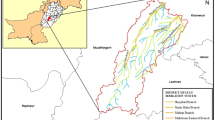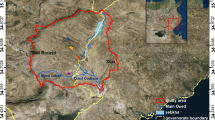Abstract
Understanding irrigation expansion and its implications on water availability is critical for development of decision support tools for sustainable water resources planning. Irrigation expansion in the Lake Tana Basin of Ethiopia from 1986 to 2016 was examined using image classification from thematic maps and remote sensing imagery (Landsat5-8 TM/ETM+, OLI). The soil-adjusted vegetation index (SAVI) imagery was used to identify irrigated cropland based on greenness. Irrigation water consumption was determined by calculating irrigation water requirements of the major crops grown with irrigation and using the estimated irrigated land size of the basin. Irrigated croplands have increased in area from 55 to 65 % in the last past 30 years (from 1986 to 2016). The classification obtained is accurate to the level of 89.6% and Kappa coefficient of 0.83. The Landsat imagery is useful in tracking of the spatiotemporal patterns of irrigated croplands for water management purposes, especially in data deficient areas dotted sparsely by small holder irrigated farms. The results indicated that irrigation consumption in the basin increased from 0.380 km3 year-1 in 1986 to 0.798 km3 year-1 in 2016. It is found that the available water cannot sustain the projected irrigation expansion unless alternative water sources are found. Also, more precise irrigation technologies have to be implemented to minimize water losses.












Similar content being viewed by others
References
Abera, M. (2017). Agriculture in the Lake Tana Sub-basin of Ethiopia. In Social and Ecological System Dynamics (pp. 375–397). Springer
Abera, A., Verhoest, N. E. C., Tilahun, S. A., Alamirew, T., Adgo, E., Moges, M. M., et al. (2018). Performance of small-scale irrigation schemes in Lake Tana Basin of Ethiopia: technical and socio-political attributes. Physical Geography, 1–25. https://doi.org/10.1080/02723646.2018.1516445.
Abera, A., Verhoest, N. E., Tilahun, S. A., Alamirew, T., Adgo, E., Moges, M. M., et al. (2019a). Performance of small-scale irrigation schemes in Lake Tana Basin of Ethiopia: technical and socio-political attributes. Physical Geography, 40(3), 227–251.
Abera, A., Verhoest, N. E., Tilahun, S., Alamirew, T., Adgo, E., & Nyssen, J. (2019b). Irrigation efficiency and shallow groundwater in anisotropic floodplain soils near Lake Tana, Ethiopia. Irrigation and Drainage, 68(2), 365–378.
Abuzar, M., McAllister, A., & Morris, M. (2001). Classification of seasonal images for monitoring irrigated crops in a salinity-affected area of Australia. International Journal of Remote Sensing, 22(5), 717–726.
Addis, F., Melak, S., Tefera, B., & Kassa, H. (2016). Impacts of smallholder tree plantation in Amhara Region of Ethiopia: the case of Lay Gayint and Fagta Locuma Districts. Ethiopian Journal of Economics, 25(1), 35–58.
Alexandridis, T. K., Zalidis, G. C., & Silleos, N. G. (2008). Mapping irrigated area in Mediterranean basins using low cost satellite Earth Observation. Computers and Electronics in Agriculture, 64(2), 93–103.
Allen, R. G., Pereira, L. S., Raes, D., & Smith, M. (1998). Crop evapotranspiration-guidelines for computing crop water requirements-FAO Irrigation and drainage paper 56. FAO. Rome, 300(9), D05109.
Ambika, A. K., Wardlow, B., & Mishra, V. (2016). Remotely sensed high resolution irrigated area mapping in India for 2000 to 2015. Scientific Data, 3, 160118.
Amede, T. (2015). Technical and institutional attributes constraining the performance of small-scale irrigation in Ethiopia. Water Resources and Rural Development., 6(2212-6082), 78–91.
Beyene, A. A. (2018). Water balance, extent and efficiency of irrigation in the Lake Tana basin. Ethiopia: Ghent University.
Beyene, A., Cornelis, W., Verhoest, N. E., Tilahun, S., Alamirew, T., Adgo, E., et al. (2018). Estimating the actual evapotranspiration and deep percolation in irrigated soils of a tropical floodplain, northwest Ethiopia. Agricultural Water Management, 202, 42–56.
Burton, M. (2010). Irrigation management: Principles and practices (1st ed.). North American: Cabi.
Chance, E. W., Cobourn, K. M., & Thomas, V. A. (2018). Trend Detection for the Extent of Irrigated Agriculture in Idaho’s Snake River Plain, 1984–2016. Remote Sensing, 10(1), 145.
Congalton, R. G., & Green, K. (2008). Assessing the accuracy of remotely sensed data: principles and practices. CRC press.
Dessie, M., Verhoest, N. E., Pauwels, V. R., Adgo, E., Deckers, J., Poesen, J., et al. (2015). Water balance of a lake with floodplain buffering: Lake Tana, Blue Nile Basin, Ethiopia. Journal of Hydrology, 522, 174–186.
Döll, P. (2002). Impact of climate change and variability on irrigation requirements: a global perspective. Climatic Change, 54(3), 269–293.
Duan, Z., Gao, H., & Ke, C. (2018). Estimation of lake outflow from the poorly gauged Lake Tana (Ethiopia) using satellite remote sensing data. Remote Sensing, 10(7), 1060.
Enku, T., Tadesse, A., Yilak, D., Gessesse, A., Addisie, M., Abate, M., et al. (2014). Biohydrology of low flows in the humid Ethiopian highlands: the Gilgel Abay catchment. Biologia, 69(11), 1502–1509.
Goshu, G., & Aynalem, S. (2017). Problem overview of the Lake Tana Basin. In Social and Ecological System Dynamics (pp. 9-23): Springer.
Howell, T. A. (2003). Irrigation efficiency (Encyclopedia of water science. Marcel Dekker, New York) (pp. 467–472). New York: Marcel Dekker.
Huete A (1988) A soil-adjusted vegetation index (SAVI)'Remote Sensing of Environment, vol. 25, issue 3, pp. 259--309. 10:0034–4257
Lillesand, T., Kiefer, R. W., & Chipman, J. (2014). Remote sensing and image interpretation. John Wiley & Sons.
Malczewski, J. (2004). GIS-based land-use suitability analysis: a critical overview. Progress in Planning, 62(1), 3–65.
McCartney, M., Alemayehu, T., Shiferaw, A., & Awulachew, S. (2010). Evaluation of current and future water resources development in the Lake Tana Basin, Ethiopia (Vol. 134). IWMI.
Mulugeta, A. (2013). Modeling and analysis of Lake Tana sub basin water resource systems, Ethiopia. PhD Dissertation, Universitate Rostock, Germany.
Ozdogan, M., Yang, Y., Allez, G., & Cervantes, C. (2010). Remote sensing of irrigated agriculture: opportunities and challenges. Remote Sensing, 2(9), 2274–2304.
Paiva, E. M. C. D., Heatwole, C. D., de Paiva, J. B. D., Paiva, R. C., & Beling, F. A. (2013). Trends in streamflow in the Ibicuí River basin, Brazil: influence of rice crop irrigation. Transactions of the ASABE, 56(6), 1371–1375.
Pervez, M. S., Budde, M., & Rowland, J. (2014). Mapping irrigated areas in Afghanistan over the past decade using MODIS NDVI. Remote Sensing of Environment, 149, 155–165.
Pun, M., Mutiibwa, D., & Li, R. (2017). Land use classification: a surface energy balance and vegetation index application to map and monitor irrigated lands. Remote Sensing, 9(12), 1256.
Schowengerdt, R. A. (2007). Remote sensing: models and methods for image processing (Third Edition ed). Academic press.
Seckler, D., Molden, D., & Sakthivadivel, R. (2003) The concept of efficiency in water resources management and policy. In Water productivity in agriculture: Limits and opportunities for improvement, (pp. 37–51). Colombo, Sri Lank.
Smith, M. (1992). CROPWAT: a computer program for irrigation planning and management (Vol. 46). Food & Agriculture Org.
Tadele, D., Assefa, A., & Teketay, D. (2014). Effect of Eucalyptus camaldulensis stand conversion into crop production on growth and yield of maize: the case of Koga watershed areas in northwestern Ethiopia. Momona Ethiopian Journal of Science, 6(1), 58–69.
Teshome, A., Wale, M., Mengistu, F., & Yitaferu, B. (2009). Agricultural potentials, constraints and opportunities in the Megech and Ribb rivers irrigation project areas in the Lake Tana Basin of Ethiopia. Ethiopia: Ethiopian Nile Irrigation and Drainage Project Bahir Dar.
Thenkabail, P. S., Dheeravath, V., Biradar, C. M., Gangalakunta, O. R. P., Noojipady, P., Gurappa, C., et al. (2009). Irrigated area maps and statistics of India using remote sensing and national statistics. Remote Sensing, 1(2), 50–67.
Trotter, M., Lamb, D., Donald, G., & Schneider, D. (2010). Evaluating an active optical sensor for quantifying and mapping green herbage mass and growth in a perennial grass pasture. Crop and Pasture Science, 61(5), 389–398.
USGS. (2016). Provisional Landsat 8 surface reflectance product: product guide (version 2.0). Department of Interior. United State Geological Survey.
Vigerske, M. (2008). 3D-Visualisierung des Projektes' Koga irrigation and watershed management. Master Thesis, Technische Fachhochschule Berlin.
Wale, A., Collick, A. S., Rossiter, D. G., Langan, S., & Steenhuis, T. S. (2013). Realistic assessment of irrigation potential in the lake Tana basin, Ethiopia. In: ILRI.
Xiao, X., Boles, S., Liu, J., Zhuang, D., Frolking, S., Li, C., et al. (2005). Mapping paddy rice agriculture in southern China using multi-temporal MODIS images. Remote Sensing of Environment, 95(4), 480–492.
Zwart, S. J., & Bastiaanssen, W. G. (2004). Review of measured crop water productivity values for irrigated wheat, rice, cotton and maize. Agricultural Water Management, 69(2), 115–133.
Acknowledgements
The authors would like to express the deepest gratitude to the data collectors Bantesew Muluye, Nigus Fentahun, Atalay Zerfie and local experts from each site who involved in data collection. In addition, the authors wish to acknowledge the constructive comments given by all PhD examiners for their constructive comments on which greatly helped to improve this manuscript.
Funding
This research was supported financially and technically by the Belgian government-funded BOF scholarship and partially funded by Blue Nile Water Institute in Bahir Dar University.
Author information
Authors and Affiliations
Corresponding author
Additional information
Publisher’s note
Springer Nature remains neutral with regard to jurisdictional claims in published maps and institutional affiliations.
Supplementary Information
ESM 1
(DOCX 56.3 kb)
Rights and permissions
About this article
Cite this article
Abera, A., Verhoest, N.E.C., Tilahun, S. et al. Assessment of irrigation expansion and implications for water resources by using RS and GIS techniques in the Lake Tana Basin of Ethiopia. Environ Monit Assess 193, 13 (2021). https://doi.org/10.1007/s10661-020-08778-1
Received:
Accepted:
Published:
DOI: https://doi.org/10.1007/s10661-020-08778-1




